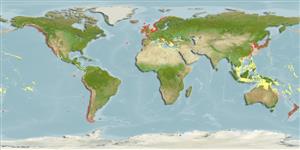Common names from other countries
Environment: milieu / climate zone / depth range / distribution range
Οικολογία
. Subtropical
Western Pacific.
Length at first maturity / Μέγεθος / Βάρος / Age
Maturity: Lm ? range ? - ? cm Max length : 3.0 cm H αρσενικό/απροσδιόριστο; (Ref. )
Relatively small with tentacular crown up to 3.5 centimeters in diameter and 3 cm in height. Smooth green-gray or brown cylindrical column that may or may not have vertical orange or white stripes. 50 to 100 slender, tapering tentacles that are fully retractile, usually transparent, sometimes gray or light green flecked with white.
Life cycle and mating behavior
Γεννητική Ωρίμανση | Αναπαραγωγή | Γεννοβολία | Αβγά | Γονιμότητα | Προνύμφες
Capable of both asexual reproduction, through longitudinal fission, and sexual reproduction through release of gametes by both sexes followed by external fertilization and embryonic development (Ref. 3248).
Cairns, S.D., D.R. Calder, A. Brinckmann-Voss, C.B. Castro, D.G. Fautin, P.R. Pugh, C.E. Mills, W.C. Jaap, M.N. Arai, S.H.D. Haddock and D.M. Opresko. 2003. (Ref. 1663)
IUCN Red List Status (Ref. 130435: Version 2024-1)
CITES status (Ref. 108899)
Not Evaluated
Not Evaluated
Threat to humans
Harmless
Human uses
| FishSource |
Εργαλεία
Περισσότερες πληροφορίες
Age/SizeΑύξησηLength-weightLength-lengthΜορφολογίαΠρονύμφεςΑφθονία
Διαδικτυακές πηγές
Estimates based on models
Preferred temperature
(Ref.
115969): 8 - 21.9, mean 12.1 (based on 886 cells).
Vulnerability
Low vulnerability (10 of 100).
Price category
Unknown.
